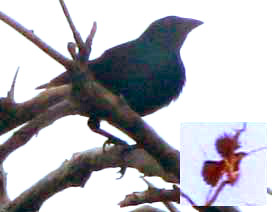Excerpts from Jim Conrad's
Naturalist Newsletter
from the July 10, 2011 Newsletter issued from Mayan Beach Garden Inn 20 kms north of Mahahual; Caribbean coastal beach and mangroves, ~N18.89°, ~W87.64°, Quintana Roo state, MÉXICO
INVASION OF SHINY COWBIRDS
In A Guide to the Birds of Mexico and Northern Central America there's an illustration of the Shiny Cowbird, MOLOTHRUS BONARIENSIS, despite the species not being listed as existing in Mexico. Author Steve Howell writes that this South American species that's been introduced into the Caribbean area "is spreading rapidly through much of Caribbean and SE USA and should be sought in places such as Isla Cozumel or Cancún... "
In 1996, just one year after Howell's masterpiece was published, the first positive identification of a Shiny Cowbird in Mexico was made near Celestún on the Yucatán's western coast. Since then the species has been seen in several places, and I'm pretty sure we have them here, too.
Out in the mangroves about a month ago I began noticing black birds singing from snags here and there. At first I thought they were Melodious Blackbirds because of their varied, bubbly, sometimes squeaky calls, though I'd not heard those particular sounds from Melodious Blackbirds around my hut up at Chichén Itzá. I thought that maybe I was hearing a regional accent. On my first visit to New York I didn't recognize the Starlings there because they made such different sounds from those I knew in Kentucky. Also, these black mangrove birds had shorter tails than Melodious Blackbirds, shorter, thicker-based bills, and they were more nervous about being approached.
One day I glimpsed a modest glimmer of bluishness as one of the mangrove birds flew from his perch, and that was when I started thinking "Shiny Cowbird," which Howell describes as having glossy, blue-black wings and tail.
They're nervous birds and I haven't been able to get good pictures. I did make a brief video from a distance, of a singing bird, which I'm keeping just as a voucher in case a future researcher needs it. Below, you can see a bird's profile and flight silhouette.

In the larger image can you see the hint of blueness that's so distinctive of the Shiny Cowbird? The thick-based beak arising so high on the forehead is very cowbirdy. The Bronzed or Red-eyed Cowbird also is found here, but it lacks the bluishness, is more thick-necked, has a thicker beak and raises its neck ruff.
The Shiny Cowbird's presence in this part of the world is nothing to celebrate because the birds are nest parasites -- females lay their eggs in the nests of other species, at the expense of the other species' nestlings. Already Shiny Cowbirds are suspected in the decline of several Caribbean bird species, including Puerto Rico's critically endangered Yellow-shouldered Blackbird.